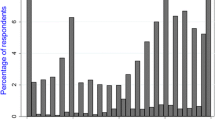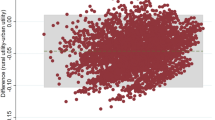Abstract
Background
Previous studies suggest that population subgroups have different perceptions of health, as well as different preferences for hypothetical health states.
Objective
To identify determinants of health states preferences elicited using time trade-off (TTO) for the 5-level EQ-5D questionnaire (EQ-5D-5L) in Canada.
Methods
Data were from the Canadian EQ-5D-5L Valuation Study, which took place in Edmonton, Hamilton, Montreal, and Vancouver. Each respondent valued 10 of 86 hypothetical health states during an in-person interview using a computer-based TTO exercise. The TTO scores were the dependent variable and explanatory variables including age, sex, marital status, education, employment, annual household income, ethnicity, country of birth, dwelling, study site, health literacy, number of chronic conditions, previous experience with illness, and self-rated health.
Results
Average [standard deviation (SD)] age of respondents (N = 1209) was 48 (17) years, and 45 % were male. In multivariable linear regression models with random effects, adjusted for severity of health states and inconsistencies in valuations, older age [unstandardized regression coefficient (β) = −0.077], male sex (β = 0.042), being married (β = 0.069), and urban dwelling (β = −0.055) were significantly associated with health states scores. Additionally, participants from Edmonton (β = −0.124) and Vancouver (β = −0.156), but not those from Hamilton, had significantly lower TTO scores than those from Montreal.
Conclusions
Socio-demographic characteristics were the main determinants of preferences for EQ-5D-5L health states in this study. Interestingly, preferences were significantly lower in western Canadian cities compared to eastern ones, bringing into question whether a single preference algorithm is suitable for use in all parts of Canada.
Similar content being viewed by others
References
Drummond, M. F., O’Brien, B. J., Stoddart, G. L., & Torrance, G. W. (1997). Methods for the economic evaluation of health care programmes (2nd ed.). Oxford: Oxford University Press.
Streiner, D. L., & Norman, G. R. (2003). Health Measurement Scales: A practical guide to their development and use. New York: Oxford University Press.
Feeny, D. (2000). A utility approach to the assessment of health-related quality of life. Medical Care, 38(9), 151–154.
Rabin, R., & de Charro, F. (2001). EQ-5D: A measure of health status from the EuroQol group. Annals of Medicine, 33(5), 337–343.
Dolders, M. G., Zeegers, M. P., Groot, W., & Ament, A. (2006). A meta-analysis demonstrates no significant differences between patient and population preferences. Journal of Clinical Epidemiology, 59(7), 653–664.
Peeters, Y., & Stiggelbout, A. M. (2010). Health state valuations of patients and the general public analytically compared: A meta-analytical comparison of patient and population health state utilities. Value Health, 13(2), 306–309.
Ubel, P. A., Loewenstein, G., & Jepson, C. (2003). Whose quality of life? A commentary exploring discrepancies between health state evaluations of patients and the general public. Quality of Life Research, 12(6), 599–607.
Craig, B. M., Reeve, B. B., Cella, D., Hays, R. D., Pickard, A. S., & Revicki, D. A. (2014). Demographic differences in health preferences in the United States. Medical Care, 52(4), 307–313.
Pickard, A. S., Tawk, R., & Shaw, J. W. (2013). The effect of chronic conditions on stated preferences for health. The European Journal of Health Economics, 14(4), 697–702.
Shaw, J. W., Johnson, J. A., Chen, S., Levin, J. R., & Coons, S. J. (2007). Racial/ethnic differences in preferences for the EQ-5D health states: results from the U.S. valuation study. Journal of Clinical Epidemiology, 60(5), 479–490.
Gandhi, M., Thumboo, J., Luo, N., Wee, H. L., & Cheung, Y. B. (2015). Do chronic disease patients value generic health states differently from individuals with no chronic disease? A case of a multicultural Asian population. Health and Quality of Life Outcomes, 13(1), 1–9.
Kind, P., & Dolan, P. (1995). The effect of past and present illness experience on the valuations of health states. Medical Care, 33(Suppl. 4), AS255–AS263.
Krabbe, P. F., Tromp, N., Ruers, T. J., & van Riel, P. L. (2011). Are patients’ judgments of health status really different from the general population? Health and Quality of Life Outcomes, 11(9), 31.
Little, M. H., Reitmeir, P., Peters, A., & Leidl, R. (2014). The impact of differences between patient and general population EQ-5D-3L values on the mean tariff scores of different patient groups. Value in Health, 17(4), 364–371.
Albrecht, G. L., & Devlieger, P. J. (1999). The disability paradox: High quality of life against all odds. Social Science and Medicine, 48(8), 977–988.
Xie, F., Pullenayegum, E., Gaebel, K., Bansback, N., Bryan, B., Ohinmaa, A., et al. (2015). A time trade-off-derived value set of EQ-5D-5L for Canada. Medical Care.
Oppe, M., Devlin, N. J., van Hout, B., Krabbe, P. F. M., & de Charro, F. (2014). A programme of methodological research to arrive at the new international EQ-5D-5L valuation protocol. Value in Health, 17(4), 445–453.
Herdman, M., Gudex, C., Lloyd, A., Janssen, M., Kind, P., Parkin, D., et al. (2011). Development and preliminary testing of the new five-level version of EQ-5D (EQ-5D-5L). Quality of Life Research, 20(10), 1727–1736.
Devlin, N. J., Tsuchiya, A., Buckingham, K., & Tilling, C. (2011). A uniform time trade off method for states better and worse than dead: Feasibility study of the ‘lead time’ approach. Health Economics, 20(3), 348–361.
Attema, A. E., Versteegh, M. M., Oppe, M., Brouwer, W. B., & Stolk, E. A. (2013). Lead time TTO: Leading to better health state valuations? Health Economics, 22(4), 376–392.
Gorber, S. C., Shields, M., Tremblay, M. S., & McDowell, I. (2008). The feasibility of establishing correction factors to adjust self-reported estimates of obesity. Health Reports, 19(3), 71–82.
Berkman, N., Terry, D., & McCormack, L. (2010). Health literacy: What is it? Journal of Health Communication, 15(Suppl 2), 9–19.
Chew, L. D., Griffin, J. M., Partin, M. R., Noorbaloochi, S., Grill, J. P., Snyder, A., et al. (2008). Validation of screening questions for limited health literacy in a large VA outpatient population. Journal of General Internal Medicine, 23(5), 561–566.
Fortin, M., Bravo, G., Hudon, C., Vanasse, A., & Lapointe, L. (2005). Prevalence of multimorbidity among adults seen in family practice. The Annals of Family Medicine, 3(3), 223–228.
Soroka, S. N. (2007). Canadian perceptions of the health Care system: A report to the Health Council of Canada. Toronto, ON: Health Council of Canada.
Allin, S. (2008). Does equity in healthcare use vary across Canadian Provinces? Healthcare Policy, 3(4), 83–99.
Barua, B. (2013). Provincial Healthcare Index 2013. Vancouver: Fraser Institute.
Dolan, P. (2011). Thinking about it: Thoughts about health and valuing QALYs. Health Economics, 20(12), 1407–1416.
Acknowledgments
This project was supported by an operating Grant from the Canadian Institutes for Health Research (#MOP 111076) and funding support from the EuroQol Research Foundation. Feng Xie and Eleanor Pullenayegum are supported by Canadian Institutes of Health Research New Investigator Awards (2012–2017). Jeffrey Johnson is a Senior Health Scholar with Alberta Innovates Health Solutions.
Author information
Authors and Affiliations
Corresponding author
Ethics declarations
Conflict of interest
All authors have no conflicts of interest to declare.
Ethical approval
The Health Research Ethics Boards at the Universities of Alberta, McMaster, and British Columbia and the Ethics Board of the Centre for Interdisciplinary Research in Rehabilitation of Greater Montreal approved the data collection protocols and survey instruments.
Informed consent
Informed consent was obtained from all individual participants included in the study.
Electronic supplementary material
Below is the link to the electronic supplementary material.
Rights and permissions
About this article
Cite this article
Sayah, F.A., Bansback, N., Bryan, S. et al. Determinants of time trade-off valuations for EQ-5D-5L health states: data from the Canadian EQ-5D-5L valuation study. Qual Life Res 25, 1679–1685 (2016). https://doi.org/10.1007/s11136-015-1203-4
Accepted:
Published:
Issue Date:
DOI: https://doi.org/10.1007/s11136-015-1203-4




